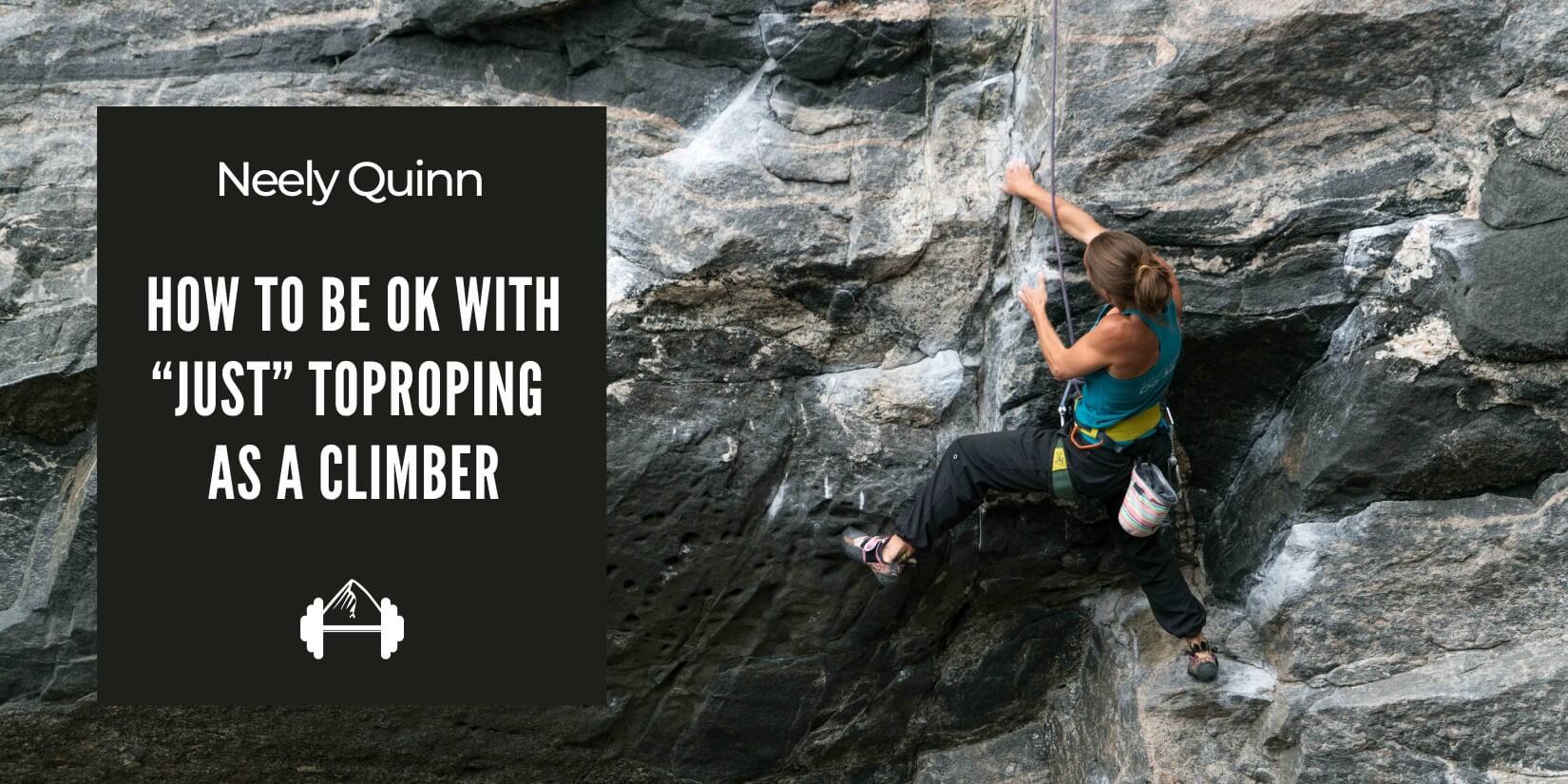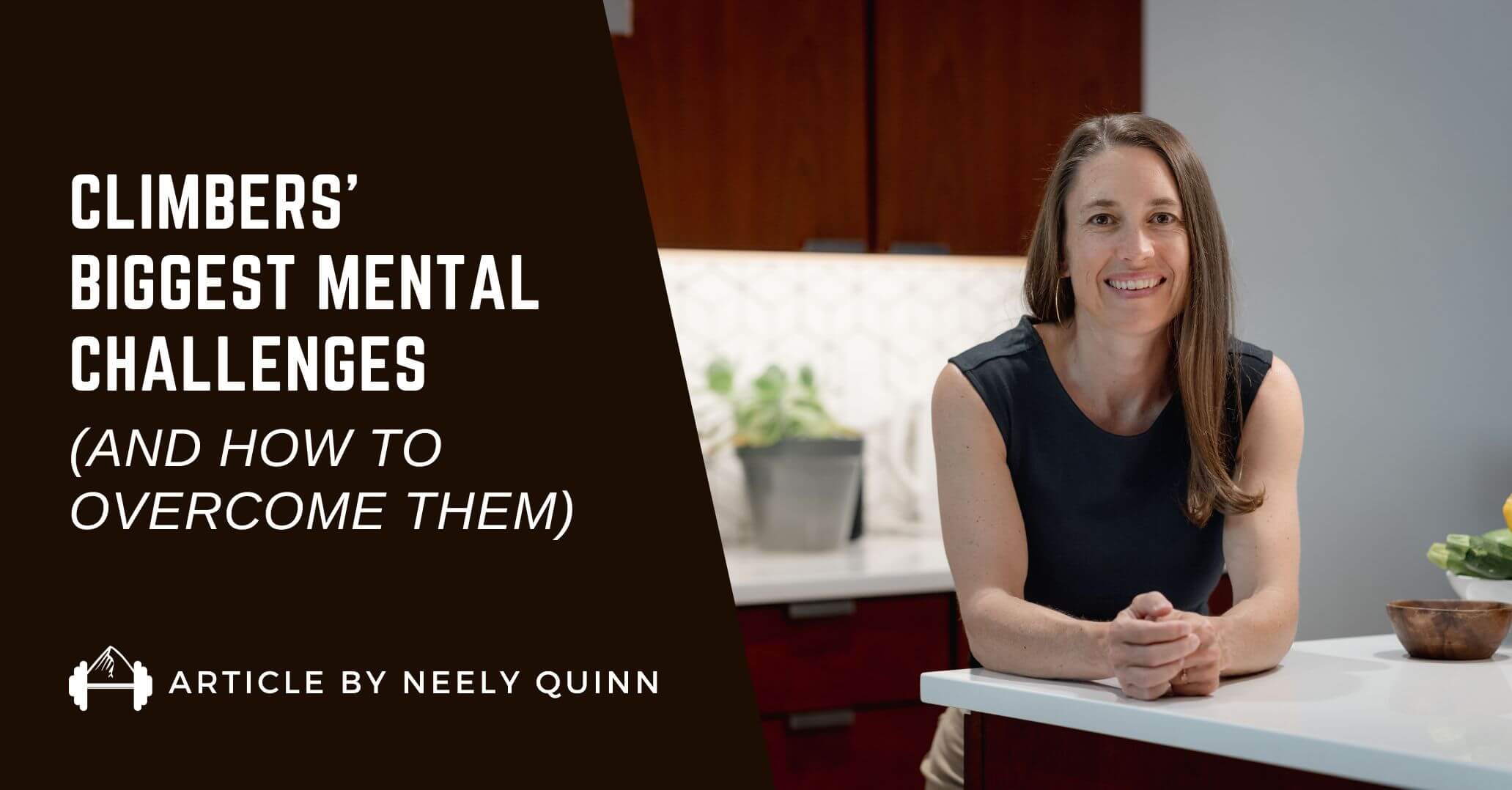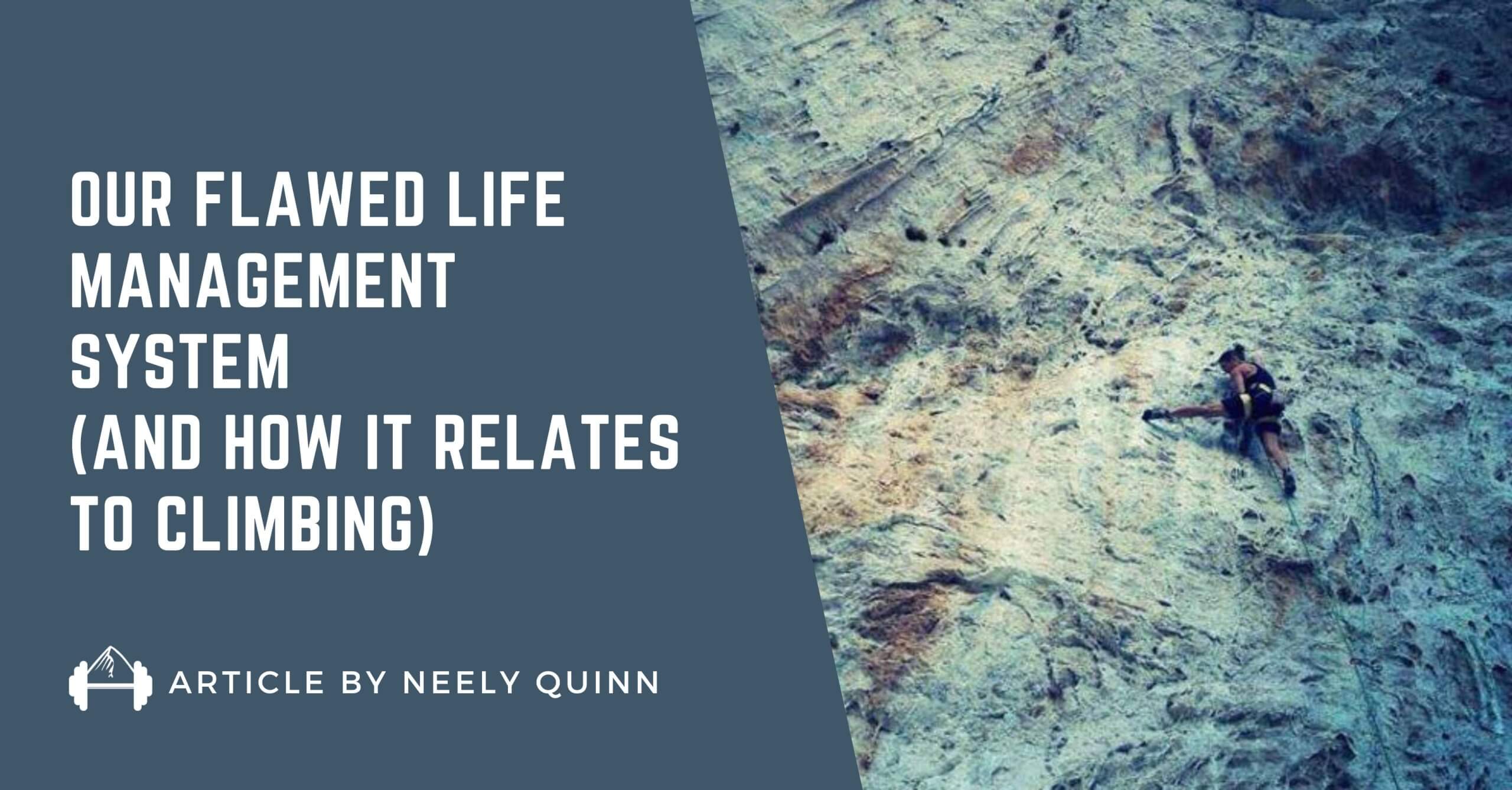I got this email recently in response to a blog post I wrote about how I deal with my fear in climbing. In the article, I mentioned that it’s totally fine if you’re so scared that you don’t want to lead climb–ever–and that my mother-in-law only topropes as a 5.12 climber (in the gym) and she’s totally fine with that.
Here’s the email:
I just wanted to write to tell you that your blog post on fear came at a great time for me. I’m currently [on a trip] with my husband climbing for 3 weeks. Going into this trip I knew it would be difficult for me, as I deal with a loooot of fear leading and the bolting here is sparse (especially on lower grades.) The hardest route I’ve ever been able to mentally climb is 5.11a, yet I can do v4 moonboard benchmarks.
I climb with people much stronger than me all the time, as my husband climbs 5.13 regularly, and most of our friends are in that same area. Anyway today my husband asked me why I don’t just toprope all the time. Pick a route that’s hard for me and stick clip up it and work it out and call it quits when I can send it on TR. He says he can tell I am more relieved than happy when I clip the chains on lead, that I really don’t enjoy it.
He likened me to a cat dressed as a dog. “You’ve been dressing as a dog for years because you think people like dogs, but really you’re a cat.” I feel so seen suddenly, like my truth was discovered, and so upset over this because I think he’s right.
I do feel like it’s not a real send if it’s not on lead.
I see other people leading and I think it looks fun and I want to be like them. But then I get above my bolt and I’m terrified. All I can think about is being scared of falling. Truthfully I haven’t been hiding my cat-like tendencies well at all, so I don’t know why I feel so surprised. I’ve tried the falling drills and done various programs and even had a climbing therapist for a little bit. It gets better throughout the season but then I usually take a break and ski during the winter (my real passion sport) and by spring I am back at square one shaking like a leaf on lead.
I am curious how your mother-in-law deals mentally with just toproping? I do have more fun on toprope. But I also feel like there is a satisfaction and clout that only comes from leading. I didn’t want to leave all of this as a comment on the blog but wanted to blurt out my thoughts. I’m still trying to figure out how I should handle this. Thanks for sharing about your fear. It makes people like me feel less alone.

Let’s Stop “Shoulding” on Ourselves
I first want to say thank you to this reader for her vulnerability, and I put her message into this post as anonymously as I could so that more people might find comfort in her words. I know there are a lot of people who feel exactly the same about not wanting to lead climb, but they love climbing and want to feel at peace with themselves.
What I’m noticing in all of my mindset coaching sessions is that all the climbers I’ve worked with are doing a lot of “shoulding” on themselves, which is a term I first heard from Dr. Jen Dragonette in our podcast episode on psychological tools for climbers. I should not be scared – what’s wrong with me? I should be able to lead hard stuff just like my friends and husband. I should be able to climb harder grades – why am I so weak? Lots of shoulds and lots of harsh judgments.
This isn’t surprising. I’ve known from working with climbers for years that we are a hard-headed breed of over-achievers, and over-achieving doesn’t come out of thin air: It comes from having strong judgments about what is good and what is bad. What is strong and what is weak. What is acceptable to you–and about you.
Our sport is quantitative by design. There’s a numbered grading system for God’s sake. It’s black and white. There are RULES to follow:
The “Rules” of Climbing
- Get to the anchor or top of the boulder without cheating in any way (pulling on holds on other routes in the gym, weighting the rope, dabbing the pad, etc.).
- Once you do that, you can take the generally accepted grade of that climb, which then becomes a discrete identifier of your abilities as a climber.
- If you’re climbing a route, you must lead it to take the grade.
- The higher the grade, the better and stronger you are.
Those are the “rules,” but when you think about it, the rules don’t mean anything. We’re simply climbing up arbitrary pieces of stone that end at arbitrary heights of a rock wall or boulder because somebody claimed it at some point as a climb worth repeating and gave it a name.
Why My Mother-in-Law Is Ok with “Just” Toproping
The reason my mother-in-law is ok with just toproping is because she understands very well that the rules are meaningless, unless you’re trying to become a professional climber or win a competition, neither of which she is aspiring to do. Could she log her ascents (if she were ever to climb outside, that is) on 8a.nu? No, the rules of 8a.nu are that you have to lead the climb to take it. But she doesn’t even know what 8a.nu is.
All she’s trying to do is get a good bout of exercise, improve her bone density, get out of the house, and have fun with her friends. She’s trying to solve puzzles on a wall full of plastic holds just like she solves her sudoku puzzles every day. She learned a long time ago that when she lead climbs, she overgrips and clipping flares up her wrists, and that’s not worth it to her. She’s trying to stay strong into old age so that we don’t have to take care of her too much when she’s older. She’s trying to learn about movement and keep her mind sharp by challenging herself 3 times a week at the gym. She just loves it.

The author toproping in Flatanger because sometimes those big steep walls are intimidating and it’s more fun to try them on toprope.
We have to remember that lead climbing is all relative too.
When I started climbing, if a route already had draws on it and you got to the anchors without falling or taking, it was not a redpoint; it was a pink point. That stemmed from old trad climbing ethics, but those have been mostly erased now in sport climbing and everyone takes a redpoint for their sends of routes with draws on them. Also, remember when people didn’t use crash pads, kneepads, hand jammies, or sticky rubber climbing shoes?
It’s all arbitrary and rules change over time. What is acceptable in climbing is not actually black and white.
So you “send” something on toprope – just call it a “TR send” and take stock of all the things that went really well on your way to that TR send. Did you try hard and challenge yourself? Were you able to think clearly and get into a state of flow on your way up because you weren’t gripped by fear? Did you learn something about rock climbing movement or tactics? Did you have to harness your focus and breathing in order to make it happen? Did you experience positive emotions like elation, relief, or fulfillment afterward? Did you have fun?
All of those things are 100% valid motivations to climb, and none of them requires being on the sharp end of a rope. Those experiences are downright inspiring reasons to climb, actually. They’re things that most people NEVER get to experience in their lives, so how much does it really matter to you whether it’s on toprope or lead?
Taking the Ego Out of Climbing (Easier Said than Done)
Our egos are very wrapped up in climbing, and I’ve had to learn that the hard way my entire climbing career. I’m reading The Zen of Climbing right now by Francis Sanzaro and he gets really granular about how our egos show up in our attachments to everything climbing related. We’re attached to the send, how we think it would make us feel to send a certain grade, and everything in between. We’re attached to the idea that climbing in a certain style or a certain grade will give us “clout” as you said, or respect from our peers.
What he focuses on is that our best performances and most fulfilling experiences with climbing actually happen in the times when we’re focused on one thing: doing one move after the other. Breathing, moving, and synthesizing our movements with our minds. Letting our bodies do what they know how to do. And accepting any outcome and just moving for the love of the movement.
That’s all easier said than done because we’re faced constantly by our comparisons of ourselves to others. But when you asked how my mother-in-law deals mentally with just toproping, I don’t think she “deals” with it at all. I think she just really loves climbing and has found a way to hold that as her very highest priority when she’s doing it. She knows that everyone she cares about loves her and respects her no matter if she’s leading or toproping, and furthermore, if someone does NOT love her or respect her because of that then that is their own problem to face.
I’m Not Suggesting That Everyone Toprope
To be clear, I’m not saying that I think everyone should stop lead climbing and start toproping. I’m simply saying that if you have done “the work” we have available to us to help decrease your fear, which it sounds like you have, and you seem to have more of a built-in fear of heights/falling than you’d like (which is perfectly normal given that we are hard-wired to be scared of both of those things), then toproping is a wonderful option that’s available to you.
And I have a feeling you and everyone around you will have a better time at the crag when you’re not terrified every time you climb. If you can accept that about yourself, then the world is your oyster as long as you have a ropegun or a stick clip and a willing belayer.

The author toproping again in Flatanger, having the time of her life.
Some Questions to Ask Yourself
Those are my thoughts on the topic, but I want to leave you with some questions to ask yourself as well so you can get to know what’s underneath all of these “shoulds.”
- What do you love about climbing? List as many things as you can, physically, mentally, socially, environmentally, etc.
- What do you respect about yourself as a climber?
- What do you respect about others as climbers? (When I was doing this work myself, Hazel Findlay asked me this question and I realized it was not just climbers’ bravery or strength that I respect. I respect how they carry themselves, how kind they are, how much fun I have with them, how supportive they are, etc. so try to think outside the box here.)
- What do you think will happen if you decide for now that you want to toprope most or all of the time?
- How true are those things in reality?
- What do you think the people you care about will think or say if you tell them you’re going to be toproping most or all of the time?
- What is the core value (if any) that you’d be compromising by toproping instead of leading? (ex: integrity, respect, courage, leadership, etc. Here’s a big list of values.)
- Given what you know now, how could your interpretation of the situation be changed in order for you to realize that you’re not actually compromising your value by choosing to toprope?
- How can you find acceptance around being a cat and not a dog? 🙂
I hope that all of this at least gives you a starting point for a shift in your perception of yourself, others, and the value of climbing (whether on lead or toprope) so you can enjoy climbing for the gift that it is a little bit more.
Work with Me on Your Own Fears in Climbing
If you want help with your fears in climbing, your mindset overall, or anything else in your life, I’m a Certified Professional Coach, aka a mindset coach, and I’d love to work with you.
We can talk through the origins of your fears, what is actually going on underneath them, and what you can do that is specific to YOU to start to work with them and overcome them. Whether it’s fear of failure, fear of success, fear of being in the spotlight, or fear of experiencing discomfort due to trying hard (or anything else), we can work through it.
About the Author, Neely Quinn

Neely Quinn is the founder of TrainingBeta.com, the host of the TrainingBeta Podcast, a Certified Integrated Clinical Nutrition Therapist specializing in rock climbers, and a Certified Professional Coach who helps climbers with their mindset. She has been climbing since 1997 and is continuously striving to become a more masterful climber using training, nutrition, and mindset.
She lives in Longmont, Colorado and Las Vegas, Nevada with her husband and co-founder of TrainingBeta, Seth Lytton, and their heeler mix, Willa.
You can find her nutrition services here and her coaching services here.





Leave A Comment